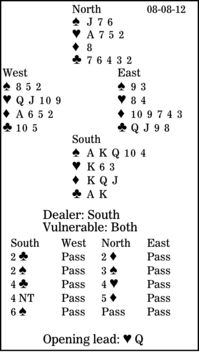Bridge column, August 8: Combining the two to dump a loser

We are looking at eliminating losers from declarer's hand. Sometimes he can discard a loser. In other deals, he ruffs a loser on the board. But occasionally he must combine those two extremes, first discarding a loser from the board, then ruffing his hand's loser on the board.
Today's deal gives an example of this two-step technique. South is in six spades. West leads the heart queen. How should declarer proceed?
In the auction, South's first two bids showed a very strong hand with five-plus spades. North promised some values (usually 4 to 7 support points) with his three-spade raise. Four clubs and four hearts were control-bids (cue-bids) expressing interest in a slam. Then South cautiously used Blackwood before bidding six spades.
Declarer has two hand-losers: one heart and one diamond. If all goes well, he can first discard two hearts from the dummy on two high diamonds. Then he can ruff his third heart on the board.
The play goes: heart queen to dummy's ace, one top trump from hand, diamond jack to West's ace, heart nine to declarer's king, second top trump, two winning diamonds (discarding dummy's remaining hearts), heart ruff with the spade jack, club to the ace, a third top spade to draw the missing trump, and claim.
** ** **
COPYRIGHT: 2012, UNITED FEATURE SYNDICATE
DISTRIBUTED BY UNIVERSAL UCLICK FOR UFS

